Joshua
Joshua (/ˈdʒɒʃuə/), also known as Yehoshua (Hebrew: יְהוֹשֻׁעַ Yəhōšuaʿ, Tiberian: Yŏhōšuaʿ, lit. 'Yahweh is salvation')[lower-alpha 2][2][3] or Josue,[4] functioned as Moses' assistant in the books of Exodus and Numbers, and later succeeded Moses as leader of the Israelite tribes in the Book of Joshua of the Hebrew Bible.[5] His name was Hoshea (הוֹשֵׁעַ Hōšēaʿ, lit. 'Save')[6] the son of Nun, of the tribe of Ephraim, but Moses called him "Yehoshua" (translated as "Joshua" in English),[7] the name by which he is commonly known in English. According to the Bible, he was born in Egypt prior to the Exodus.
Joshua | |
|---|---|
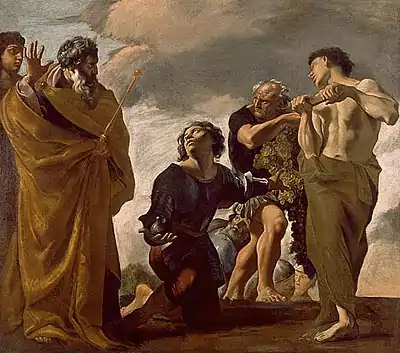 Moses and the Messengers from Canaan, Giovanni Lanfranco, oil on canvas, 218 cm × 246 cm (85+3⁄4 by 97 inches), at the J. Paul Getty Museum, Los Angeles | |
| Prophet, Righteous, Forefather | |
| Born | Goshen (Lower Egypt), Ancient Egypt |
| Died | Canaan |
| Venerated in | Judaism, Christianity, Islam |
| Major shrine |
|
| Feast |
|
| Attributes | Often depicted with Caleb, carrying the grapes out of Canaan |
| Judges in the Hebrew Bible שופטים |
|---|
| Italics indicate individuals not explicitly described as judges |
| Book of Exodus |
| Book of Joshua |
| Book of Judges |
| First Book of Samuel |
The Hebrew Bible identifies Joshua as one of the twelve spies of Israel sent by Moses to explore the land of Canaan. In Numbers 13:1 and after the death of Moses, he led the Israelite tribes in the conquest of Canaan, and allocated lands to the tribes. According to biblical chronology, Joshua lived some time in the Bronze Age. According to Joshua 24:29 Joshua died at the age of 110.
Joshua holds a position of respect among Muslims, who also see him as the leader of the faithful following the death of Moses. In Islam, it is also believed that Yusha bin Nun (Joshua) was the "attendant" of Moses mentioned in the Quran before Moses meets Khidr. Joshua plays a role in Islamic literature, with significant narration in the hadith.[8][9]
Name
The English name "Joshua" is a rendering of the Hebrew Yehoshua, and is mostly interpreted as "Yahweh is salvation";[10][11] although others have also alternatively interpreted it as "Yahweh is lordly".[12] The theophoric name appears to be constructed from a combination of the Tetragrammaton with the Hebrew noun יְשׁוּעָה (Modern: yəšūʿa, Tiberian: yăšūʿā), meaning "salvation";[13][14][15][16] derived from the Hebrew root ישׁע (y-š-ʿ), meaning "to save/help/deliver".[17][18] Other theophoric names sharing a similar meaning can also be found throughout the Hebrew Bible, such as that of the son of David אֱלִישׁוּעַ (ʾĔlīšūaʿ), whose name means "My El (God) is salvation".[19][20]
"Jesus" is the English derivative of the Greek transliteration of "Yehoshua" via Latin. In the Septuagint, all instances of the word "Yehoshua" are rendered as "Ἰησοῦς" (Iēsoūs), the closest Greek pronunciation of the Imperial Aramaic: יֵשׁוּעַ Yēšūaʿ.[21][22][23][24] Thus, in modern Greek, Joshua is called "Jesus son of Naue" (τοῦ Ναυή, toũ Nauḗ) to differentiate him from Jesus. This is also true in some Slavic languages following the Eastern Orthodox tradition (e.g. "Иисус Навин", Iisús Navín, in Bulgarian, Serbian and Russian, but not Czech).
Biblical narrative
The Exodus

Joshua was a major figure in the events of the Exodus. He was charged by Moses with selecting and commanding a militia group for their first battle after exiting Egypt, against the Amalekites in Rephidim,[25] in which they were victorious.
He later accompanied Moses when he ascended biblical Mount Sinai to commune with God,[26] visualize God's plan for the Israelite tabernacle and receive the Ten Commandments. Joshua was with Moses when he descended from the mountain, heard the Israelites' celebrations around the Golden Calf,[27] and broke the tablets bearing the words of the commandments. Similarly, in the narrative which refers to Moses being able to speak with God in his tent of meeting outside the camp, Joshua is seen as custodian of the tent ('tabernacle of meeting') when Moses returned to the Israelite encampment.[28] However, when Moses returned to the mountain to re-create the tablets recording the Ten Commandments, Joshua was not present, as the biblical text states "no man shall come up with you".[29]
Later, Joshua was identified as one of the twelve spies sent by Moses to explore and report on the land of Canaan,[30] and only he and Caleb gave an encouraging report, a reward for which would be that only these two of their entire generation would enter the promised land.[31]
According to Joshua 1:1,[32] God appointed Joshua to succeed Moses as leader of the Israelites along with giving him a blessing of invincibility during his lifetime.[33][34] The first part of the book of Joshua covers the period when he led the conquest of Canaan.
Conquest of Canaan

At the Jordan River, the waters parted, as they had for Moses at the Red Sea. The first battle after the crossing of the Jordan was the Battle of Jericho. Joshua led the destruction of Jericho, then moved on to Ai, a small neighboring city to the west. However, they were defeated with thirty-six Israelite deaths. The defeat was attributed to Achan taking an "accursed thing" from Jericho; and was followed by Achan and his family and animals being stoned to death to restore God's favor. Joshua then went to defeat Ai.
The Israelites faced an alliance of five Amorite kings from Jerusalem, Hebron, Jarmuth, Lachish, and Eglon. At Gibeon, Joshua asked the LORD to cause the sun and moon to stand still, so that he could finish the battle in daylight. According to the text, the sun stopped in the middle of the sky and delayed going down about a full day. This event is most notable because "There has been no day like it before or since, when the LORD heeded the voice of a man, for the Lord fought for Israel."[35] The LORD also fought for the Israelites in this battle, for he hurled huge hailstones from the sky which killed more Canaanites than those which the Israelites slaughtered. From there on, Joshua was able to lead the Israelites to several victories, securing much of the land of Canaan. He presided over the Israelite gatherings at Gilgal and Shiloh which allocated land to the tribes of Israel (Joshua 14:1–5 and 18:1–10), and the Israelites rewarded him with the Ephraimite city of Timnath-heres or Timnath-serah, where he settled (Joshua 19:50).
According to the Talmud, Joshua in his book enumerated only those towns on the frontier.[lower-alpha 3]
Death
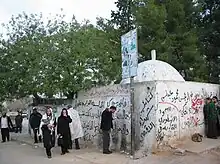

When he was "old and well advanced in years",[36] Joshua convened the elders and chiefs of the Israelites and exhorted them to have no fellowship with the native population, because it could lead them to be unfaithful to God.[37] At a general assembly of the clans at Shechem, he took leave of the people, admonishing them to be loyal to their God, who had been so mightily manifested in the midst of them. As a witness of their promise to serve God, Joshua set up a great stone under an oak by the sanctuary of God. Soon afterward he died, at the age of 110, and was buried at Timnath-heres, in the hill country of Ephraim, north of Mount Gaash.[38]
Historicity
Current mainstream opinion
The prevailing scholarly view is that the Book of Joshua is not a factual account of historical events.[39][40] The apparent setting of Joshua is the 13th century BCE[41] which was a time of widespread city-destruction, but with a few exceptions (Hazor, Lachish) the destroyed cities are not the ones the Bible associates with Joshua, and the ones it does associate with him show little or no sign of even being occupied at the time.[42] Given its lack of historicity, Carolyn Pressler in her commentary for the Westminster Bible Companion series suggests that readers of Joshua should give priority to its theological message ("what passages teach about God") and be aware of what these would have meant to audiences in the seventh and sixth centuries BCE.[43] Richard Nelson explained that the needs of the centralised monarchy favoured a single story of origins, combining old traditions of an exodus from Egypt, belief in a national god as "divine warrior," and explanations for ruined cities, social stratification and ethnic groups, and contemporary tribes.[44]
It has been argued that the Book of Joshua holds little historical value.[45] The archaeological evidence shows that Jericho and Ai were not occupied in the Near Eastern Late Bronze Age,[46] although recent excavations at Jericho have questioned this.[47] The story of the conquest perhaps represents the nationalist propaganda of the eighth century BCE kings of Judah and their claims to the territory of the Kingdom of Israel,[39] incorporated into an early form of Joshua written late in the reign of king Josiah (reigned 640–609 BCE). The book was probably revised and completed after the fall of Jerusalem to the Neo-Babylonian Empire in 586 BCE, and possibly after the return from the Babylonian exile in 538 BCE.[48]
M. Noth (1930s)
In the 1930s Martin Noth made a sweeping criticism of the usefulness of the Book of Joshua for history.[49] Noth was a student of Albrecht Alt, who emphasized form criticism and the importance of etiology.[49][50] Alt and Noth posited a peaceful movement of the Israelites into various areas of Canaan, contra the Biblical account.[51]
W.F. Albright (1930s)
William Foxwell Albright questioned the "tenacity" of etiologies, which were key to Noth's analysis of the campaigns in Joshua. Archaeological evidence in the 1930s showed that the city of Ai, an early target for conquest in the putative Joshua account, had existed and been destroyed, but in the 22nd century BCE.[49] Some alternate sites for Ai have been proposed which would partially resolve the discrepancy in dates, but these sites have not been widely accepted.[52]
K. Kenyon (1951)
In 1951 Kathleen Kenyon showed that City IV at Tell es-Sultan (Jericho) was destroyed at the end of the Middle Bronze Age (c. 2100–1550 BCE), not during the Late Bronze Age (c. 1550–1200 BCE). Kenyon argued that the early Israelite campaign could not be historically corroborated, but rather explained as an etiology of the location and a representation of the Israelite settlement.[53][54]
G.E. Wright (1955)
In 1955, G. Ernest Wright discussed the correlation of archaeological data to the early Israelite campaigns, which he divided into three phases per the Book of Joshua. He pointed to two sets of archaeological findings that "seem to suggest that the biblical account is in general correct regarding the nature of the late thirteenth and twelfth-eleventh centuries in the country" (i.e., "a period of tremendous violence").[55] He gives particular weight to what were then recent digs at Hazor by Yigael Yadin.[55]
Religious views
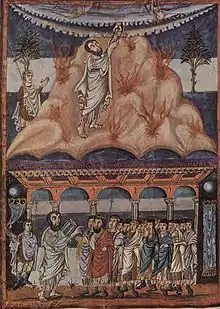
In rabbinical literature
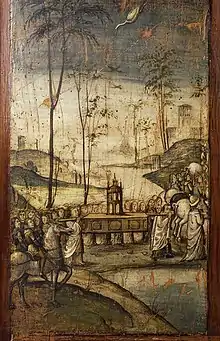
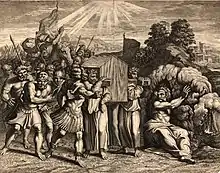
In rabbinic literature Joshua is regarded as a faithful, humble, deserving, wise man. Biblical verses illustrative of these qualities and of their reward are applied to him. "He that waits on his master shall be honored"[56] is construed as a reference to Joshua,[57] as is also the first part of the same verse, "Whoso keeps the fig-tree shall eat the fruit thereof".[58] That "honor shall uphold the humble in spirit"[59] is proved by Joshua's victory over Amalek.[60] Not the sons of Moses—as Moses himself had expected—but Joshua was appointed as Moses' successor.[61] Moses was shown how Joshua reproved that Othniel.[62]
"God would speak to Moses face to face, like someone would speak to his friend. Then he would return to the camp. But his attendant, Joshua the son of Nun, a young man, would not leave the tent. Joshua never moved from the tent".[28] Didn't Joshua leave the tent to eat, sleep or attend to his needs? This praise shows that Joshua had complete faith in Moses, the Tzaddik. One who has this faith is cognizant of the tzaddik in everything he does; he remains steadfastly with the tzaddik whatever he does.[63]
According to rabbinic tradition, Joshua, when dividing the Land of Canaan among the twelve tribes of Israel, planted sea squill (Hebrew: חצוב) to mark off the butts and bounds of tribal properties.[lower-alpha 3]
Moreover, Joshua, on dividing the land of Canaan amongst the tribes of Israel, made the tribes agree to ten conditions, the most important of which being the common use of the forests as pasture for cattle, and the common right of fishing in the Sea of Tiberias.[64] Natural springs were to be used for drinking and laundry by all tribes, although the tribe to which the water course fell had the first rights.[65] Prickly burnet (Sarcopoterium spinosum) and the camelthorn (Alhagi maurorum) could be freely collected as firewood by any member of any tribe, in any tribal territory.
In prayer
According to Jewish religious tradition, upon making Aliyah by crossing the Jordan River to enter the Land of Israel, Joshua composed the Aleinu prayer thanking God. This idea was first cited in the Kol Bo of the late 14th Century.[66] Several medieval commentators noticed that Joshua's shorter birth name, Hosea, appears in the first few verses of Aleinu in reverse acrostic: ע – עלינו, ש – שלא שם, ו – ואנחנו כורעים, ה – הוא אלוקינו. The Teshuvot HaGeonim, a Geonic responsum, discussed that Joshua composed the Aleinu because although the Israelites had made Aliyah to the Promised Land, they were surrounded by other peoples, and he wanted the Jews to draw a clear distinction between themselves, who knew and accepted the sovereignty of God, and those nations of the world which did not.[67] In the modern era, religious Jews still pray the Aliyah inspired Aleinu three times daily, including on the High Holidays. The Aleinu prayer begins:
It is our duty to praise the Master of all, to exalt the Creator of the Universe, who has not made us like the nations of the world and has not placed us like the families of the earth, who has not designed our destiny to be like theirs, nor our lot like that of all their multitude.[68]
In Christianity
Most modern Bibles translate Hebrews 4:8–10 to identify Jesus as a better Joshua, as Joshua led Israel into the rest of Canaan, but Jesus leads the people of God into "God's rest". Among the early Church Fathers, Joshua is considered a type of Jesus Christ.[69]
The story of Joshua and the Canaanite kings is also alluded to in the 2 Meqabyan, a book considered canonical in the Ethiopian Orthodox Tewahedo Church.[70]
Quranic references
Joshua (Arabic: يُوشَعُ بْنُ نُونٍ, Yūšaʿ ibn Nūn [juːʃaʕ ibn nuːn], is not mentioned by name in the Quran, but his name appears in other Islamic literature. In the Quranic account of the conquest of Canaan, Joshua and Caleb are referenced, but not named, as two "Allah-fearing men", on whom Allah "had bestowed His grace".[71]
They said, "Moses, there is a fearsome people in this land. We will not go there until they leave. If they leave, then we will enter." Yet the two men whom God had blessed among those who were afraid said, "Go in to them through the gate and when you go in you will overcome them. If you are true believers, put your trust in God.
Joshua is also referred to in the journey Musa (Moses) took with him to find Khidr.
And ˹remember˺ when Moses said to his young assistant, “I will never give up until I reach the junction of the two seas, even if I travel for ages.” But when they ˹finally˺ reached the point where the seas met, they forgot their ˹salted˺ fish, and it made its way into the sea, slipping away ˹wondrously˺. He replied, “Do you remember when we rested by the rock? ˹That is when˺ I forgot the fish. None made me forget to mention this except Satan. And the fish made its way into the sea miraculously.” Moses responded, “That is ˹exactly˺ what we were looking for.” So they returned, retracing their footsteps. There they found a servant of Ours, to whom We had granted mercy from Us and enlightened with knowledge of Our Own.
The authentic narration collected by Bukhari reports that a man approached Moses after he gave a talk and asked him, “Who is the most knowledgeable person on earth?” Moses responded, “That would be me!” So Allah revealed to Moses that he should not have said this and there was in fact someone who was more knowledgeable than him. Moses was commanded to travel to meet this man, named Al-Khaḍir, at the junction of the two seas. Islamic scholars have argued this could be the northern part of the Sinai Peninsula between the Red Sea and the Mediterranean Sea, the southern part of Sinai where the Rea Sea splits into the Gulf of Suez and the Gulf of Aqaba, or the Bosporus in Istanbul which is a strait between the Black Sea and the Sea of Marmara.
Hadith, exegesis, traditions
Joshua was regarded by some classical scholars as the prophetic successor to Moses (موسى)[lower-alpha 4] Al-Tabari relates in his History of the Prophets and Kings that Joshua was one of the twelve spies, and Muslim scholars believe that the two believing spies referred to in the Quran are Joshua and Caleb. Joshua was exceptional among the Israelites for being one of the few faithful followers of Allah.
Significant events from Joshua's Muslim narratives include the crossing of the Jordan river and the conquest of Bait al-Maqdis.[74]
The traditional Muslim commentary al-Jalalayn says, "Ahmad [b. Hanbal] reported in his Musnad, the [following] hadīth, 'The sun was never detained for any human, except for Joshua during those days in which he marched towards the Holy House [of Jerusalem]'."[75]
Muslim literature includes traditions of Joshua not found in the Hebrew Bible. Joshua is credited with being present at Moses's death and literature records that Moses's garments were with Joshua at the time of his departure.[76] In Sahih Bukhari and Sahih Muslim, Joshua is mentioned as Yusha' bin Nun and is the attendant to Moses during his meeting with Khidr.[77][78][79]
In art and literature
In the literary tradition of medieval Europe, Joshua is known as one of the Nine Worthies. In The Divine Comedy Joshua's spirit appears to Dante in the Heaven of Mars, where he is grouped with the other "warriors of the faith."[80]
Baroque composer Georg Frideric Handel composed the oratorio Joshua in 1747. Composer Franz Waxman composed an oratorio Joshua in 1959. Marc-Antoine Charpentier composed Josue (H.404 and H.404 a), an oratorio for soloists, double chorus, double orchestra and continuo, in 1680.
Nomenclature in biology
According to legend, Mormon pioneers in the United States first referred to the yucca brevifolia agave plant as the Joshua tree because its branches reminded them of Joshua stretching his arms upward in supplication, guiding the travelers westward.[81]
Joshua is commemorated in the scientific name of a species of snake, Joshua's blind snake (Trilepida joshuai), the holotype of which was collected at Jericó, Antioquia, Colombia.[82]
Jewish holidays
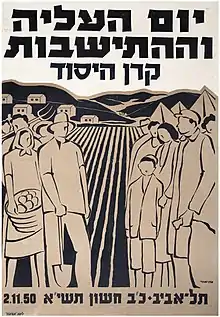
Religious holiday
The annual commemoration of Joshua's yahrtzeit (the anniversary of his death) is marked on the 26th of Nisan on the Hebrew calendar. Thousands make the pilgrimage to the Tomb of Joshua at Kifl Haris near Nablus, West Bank, on the preceding night.
Israeli Zionist holiday
Yom HaAliyah (Aliyah Day; Hebrew: יום העלייה) is an Israeli national holiday celebrated annually on the tenth of the Hebrew month of Nisan, as per the opening clause of the Yom HaAliyah Law, as a Zionist celebration of "Jewish immigration to the Land of Israel as the basis for the existence of the State of Israel", and secondarily "to mark the date of entry into the Land of Israel", i.e. to commemorate Joshua having led the Israelites across the Jordan River into the Land of Israel while carrying the Ark of the Covenant.
Tomb of Joshua
Samaritan and Jewish traditions
According to a Samaritan tradition, noted in 1877, the tombs of Joshua and Caleb were in Kifl Haris.[83]
According to Joshua 24:30, the tomb of Joshua is in Timnath-heres, and Jewish tradition also places the tombs of Joshua's father, Nun, an his companion, Caleb, at that site, which is identified by Orthodox Jews with Kifl Haris. Thousands make the pilgrimage to the tombs on the annual commemoration of Joshua's death, 26th of Nisan on the Hebrew calendar.[84]
Islamic sites
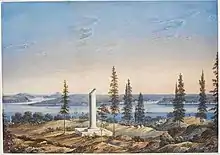
Joshua is believed by some Muslims to be buried on Joshua's Hill in the Beykoz district of Istanbul.[85] Alternative traditional sites for his tomb are situated in Israel (the Shia shrine at Al-Nabi Yusha'), Jordan (An-Nabi Yusha' bin Noon, a Sunni shrine near the city of Al-Salt[86][87]), Iran (Historical cemetery of Takht e Foolad in Esfahan[88]) and Iraq (the Nabi Yusha' shrine of Baghdad[86]). A local tradition combining three versions of three different Yushas, including biblical Joshua, places the tomb inside a cave in the Tripoli Mountains, overlooking the coastal town of el-Minyieh near Tripoli, Lebanon.[89][90]
See also
References
Explanatory notes
- (In Greek) "Ὁ Ἅγιος Ἰησοῦς ὁ Δίκαιος". Megas Synaxaristis.
- Imperial Aramaic: יֵשׁוּעַ Yēšūaʿ; Syriac: ܝܫܘܥ ܒܪ ܢܘܢ Yəšūʿ bar Nōn; Greek: Ἰησοῦς, Arabic: يُوشَعُ ٱبْنُ نُونٍ Yūšaʿ ibn Nūn; Latin: Iosue
- Babylonian Talmud, Baba Bathra 56a; Beitza 25b, s.v. חצובא מקטע רגליהון דרשיעי. Quote: "ʻThe sea squill (Urginea maritima) amputates the leg of the wicked’. Explained by Talmudic exegete, Rashi, to mean a plant whose roots penetrate and go down deeply, without spreading-out to the sides at all, and they plant it between the boundaries of fields, with which Joshua [formerly] divided the country by designated borders for Israel." ʻAmputates the leg of the wicked’, [meaning], on the Day of Judgment, in the sense that they (the wicked) steal, and covet, and reappropriate the property bounds [of others], without taking a lesson from it" (END QUOTE). Cf. Hai Gaon (1921), "Hai Gaon's Commentary on Seder Taharot", in Epstein, J.N. (ed.), The Geonic Commentary on Seder Taharot - Attributed to Rabbi Hai Gaon (in Hebrew), vol. 1, Berlin: Itzkowski, pp. 13–14, OCLC 13977130, s.v. יבלית in Mishnah Keilim 3:6.
- Joshua is mentioned as a prophet in Ibn Kathir's Stories of the Prophets
Citations
- "Righteous Joshua the son of Nun (Navi)". Oca. Archived from the original on 14 November 2012. Retrieved 8 January 2018.
- Khan, Geoffrey (2020). The Tiberian Pronunciation Tradition of Biblical Hebrew, Volume 1. Open Book Publishers. ISBN 978-1783746767.
- "Strong's Hebrew Concordance - 3091. Yehoshua". Bible Hub.
- "CATHOLIC ENCYCLOPEDIA: Josue (Joshua)". www.newadvent.org. Retrieved 2023-01-01.
- Coogan 2009, pp. 166–167.
- "Conjugation of לְהוֹשִׁיעַ". Pealim.
- Bible Numbers 13:16
- "Jami' at-Tirmidhi 3149 - Chapters on Tafsir - كتاب تفسير القرآن عن رسول الله صلى الله عليه وسلم - Sunnah.com - Sayings and Teachings of Prophet Muhammad (صلى الله عليه و سلم)". sunnah.com. Retrieved 2022-02-14.
- "Sahih Muslim 2380a - The Book of Virtues - كتاب الفضائل - Sunnah.com - Sayings and Teachings of Prophet Muhammad (صلى الله عليه و سلم)". sunnah.com. Retrieved 2022-02-14.
- Gesenius 1906, pp. 221, 446.
- "Fausset's Bible Dictionary". Study Light. Archived from the original on 16 March 2012. Retrieved 8 January 2018.
- Ayali-Darshan 2018.
- "Strong's Hebrew Concordance - 3444. yeshuah". Bible Hub.
- "Inflection of יְשׁוּעָה". Pealim.
- "Klein Dictionary, יְשׁוּעָה". Sefaria.
- "Jastrow, יְשׁוּעָה". Sefaria.
- "Strong's Hebrew Concordance - 3467. yasha". Bible Hub.
- "Klein Dictionary, ישׁע". Sefaria.
- "Strong's Hebrew Concordance - 474. Elishua". Bible Hub.
- "Strong's Hebrew Concordance - 410. êlî". Bible Hub.
- Bible Nehemiah 8:17
- Numbers 13:16 LXX Archived 2011-07-23 at the Wayback Machine καὶ ἐπωνόμασεν Μωυσῆς τὸν Αὐσῆ υἱὸν Ναυῆ 'Ἰησοῦν' (and Moses named Hosea, son of Naue, Jesus)
- "Zechariah", Online Greek OT (Septuagint/LXX) UTF8 Bible, Bible database, 3:1–10, archived from the original on 23 July 2011, retrieved 8 January 2018
- "Strong's Hebrew Concordance - 3442. Yeshua". Bible Hub.
- Bible Exodus 17:8–16
- Exodus 24:13
- Bible Exodus 32:17
- Exodus 33:11
- Exodus 34:3
- Bible Numbers 13:16–17
- Bible Numbers 14:22–24
- Bible Joshua 1:1–9
- Bible Joshua 1:5
- Goldingay 2023, pp. 67–68.
- Bible Joshua 10:14
- Bible Joshua 23:1–2
- Bible Joshua 23:7–8, 23:12–13
- Bible Joshua 24:29–30
- Coote 2000, p. 275.
- McConville & Williams 2010, p. 4.
- McConville & Williams 2010.
- Miller & Hayes 1986, pp. 71–72.
- Pressler 2002, pp. 5–6.
- Nelson 1997, p. 5.
- Killebrew 2005, p. 152: "Almost without exception, scholars agree that the account in Joshua holds little historical value vis-à-vis early Israel and most likely reflects much later historical times.15"
- Bartlett 2006, p. 63.
- Nigro 2020, pp. 202–204.
- Creach 2003, pp. 10–11.
- Albright 1939, pp. 11–23.
- Noort 1998, pp. 127–144.
- Rendsburg 1992, pp. 510–527.
- Hawkins 2013, p. 109.
- Kenyon 1967, pp. 268–275.
- Kenyon 2013, pp. 101–138.
- Wright 1955, pp. 106–108.
- Proverbs 27:18
- Numbers Rabbah 12
- Yalkut Shimoni, Joshua 2; Numbers Rabbah 12:21
- Proverbs 29:23
- Numbers Rabbah 13
- Numbers Rabbah 12
- Yalkut Shimoni, Numbers 776
- Nachman of Breslov, Likutey Halakhot VII
- Babylonian Talmud (Bava Kamma 80b—81a).
- Maimonides, Mishneh Torah (Hil. Nizkei Mammon 5:3); Acha of Shabha, Sheiltoth, P. Ra’eh 147; Jerusalem Talmud, Baba Bathra 5:1. Even if the source of the natural spring were to originate in a distant tribal territory, and flowed along its course through another tribal territory, the people living in the territory where the water currently passes through have first-rights over the water.
- "Shiur #18: Aleinu | VBM haretzion". Archived from the original on 2021-01-23. Retrieved 2021-01-30.
- "The Origins of Aleinu – Anshe Sholom". Archived from the original on 2021-07-16. Retrieved 2021-01-30.
- "Online Siddur with Commentary". Archived from the original on 2021-03-03. Retrieved 2021-01-30.
- Nichols 2007, p. 195.
- "Torah of Yeshuah: Book of Meqabyan I - III". Archived from the original on 2019-09-23. Retrieved 2019-11-10.
- Abdullah Yusuf Ali, The Holy Qur'an: Text, Translation and Commentary, Note. 726 to verse 23: "Among those who returned after spying out the land were two men who had faith and courage. They were Joshua and Caleb. Joshua afterwards succeeded Moses in the leadership after 40 years. These two men pleaded for an immediate entry through the proper Gate, which I understand to mean, 'after taking all due precautions and making all due preparations.' Cf. 2:189 and n. 203. But of course, they said, they must put their trust in Allah for victory."
- M. A. S. Abdel Haleem, translator (2005). The Qur'an. Oxford University Press. p. 70.
- "Surah Al-Kahf - 60". Quran.com. Retrieved 2023-07-14.
- Tabari, History of the Prophets and Kings, Vol. I: 414–429, 498–499, 503–516
- "QuranX.com The most complete Quran / Hadith / Tafsir collection available!". quranx.com. Archived from the original on 2018-08-15. Retrieved 2018-08-15.
- Encyclopedia of Islam, Vol. XI, pg. 351, Yusha ibn Nun [Joshua, son of Nun]
- Bukhari, Book 6, Volume 60, Hadiths 249, 250, 251: Prophetic Commentary on the Qur'an (Tafseer of the Prophet (pbuh))
- Bukhari, Book 1, Volume 3, Hadith 124: Knowledge
- Muslim, Book 30, Hadith 5864: The Book Pertaining to the Excellent Qualities of the Holy Prophet (may Peace be upon them) and His Companions (Kitab Al-Fada'il)
- Simons 2018, pp. 371–380.
- "Joshua Trees". nps.gov. National Park Service. Archived from the original on 2015-02-25. Retrieved 2013-05-27.
- Beolens, Watkins & Grayson 2011, p. 136.
- Conder and Kitchener, 1882, p. 218 - 219
- "Jews Barred from Visiting Tomb of Biblical Joshua".
- "ISTANBUL, Extended On Two Continents". Archived from the original on 6 April 2016. Retrieved 8 January 2018.
- Mazar Hazrat Yusha’ bin Noon, on the website of the Islamic Supreme Council of Canada Archived 2017-05-05 at the Wayback Machine
- Tomb of Prophet Yusha' (photo of the tomb; Islamic view on Prophet Yusha'/Joshua) Archived 2018-09-26 at the Wayback Machine
- "The buried prophets in Iran – Arash Nooraghayee". nooraghayee.com. Archived from the original on 2015-03-29. Retrieved 2020-01-15.
- The Shrine of Prophet Yusha/Joshua (pbuh) Archived 2019-07-20 at the Wayback Machine, Sacred Places in Lebanon - Holy Places in Lebanon
- El-Nabi Yusha' Mosque and Maqam Archived 2019-07-20 at the Wayback Machine, at DestinationLebanon.gov.lb, Lebanon Ministry of Tourism
General and cited sources
- Albright, W. F. (1939). "The Israelite Conquest of Canaan in the Light of Archaeology". Bulletin of the American Schools of Oriental Research. 74 (74): 11–23. doi:10.2307/3218878. JSTOR 3218878. S2CID 163336577.
- Ayali-Darshan, Noga (2018). "The Elements ש(ו)ע/שבע/תע in Biblical Proper Names: A Re-evaluation". Journal of Northwest Semitic Languages. Stellenbosch University. 44 (1). hdl:10520/EJC-ff5bd8a45.
- Auzou, Georges (1964), Le Don d'une conquête: étude du livre de Josué, Connaissance de la Bible (in French), Édition de l'Orante
- Bartlett, John R. (2006). "3: Archeology". In Rogerson, J.W.; Lieu, Judith M. (eds.). The Oxford Handbook of Biblical Studies. Oxford: Oxford University Press. ISBN 978-0-19-925425-5.
- Barton, John; Muddiman, John, eds. (2001), Oxford Bible Commentary, Oxford University Press, ISBN 9780198755005, archived from the original on 2020-07-16, retrieved 2017-05-01
- Barton, John (2004), The Biblical World, vol. 2, Taylor & Francis, ISBN 9780415350914, archived from the original on 2017-05-02, retrieved 2017-05-01
- Beolens, Bo; Watkins, Michael; Grayson, Michael (2011). The Eponym Dictionary of Reptiles. JHU Press. ISBN 978-1-4214-0135-5. Archived from the original on 2021-05-14. Retrieved 2021-05-14.
- Brettler, Marc Zvi, How to read the Bible Archived 2017-05-01 at the Wayback Machine (Jewish Publication Society, 2005).
- Bright, John (2000). A History of Israel. Westminster John Knox Press. ISBN 978-0-664-22068-6. Archived from the original on 2020-11-02. Retrieved 2020-10-04.
- Coogan, Michael D. (ed), The Oxford History of the Biblical World Archived 2020-11-15 at the Wayback Machine (Oxford University Press, 1998)
- Coogan, Michael D. (2009). A Brief Introduction to the Old Testament. Oxford: University Press.
- Coote, Robert B. (31 December 2000). "Conquest: Biblical narrative". In David Noel Freedman; Allen C. Myers (eds.). Eerdmans Dictionary of the Bible. Amsterdam University Press. ISBN 978-90-5356-503-2.
- Creach, Jerome F.D. (2003). Joshua. Westminster John Knox Press. ISBN 978-0-664-23738-7. Archived from the original on 2021-05-07. Retrieved 2021-05-12.
- Day, John, Yahweh and the gods and goddesses of Canaan Archived 2021-07-16 at the Wayback Machine (Sheffield Academic Press, 2002)
- de Pury, Albert; Römer, Thomas; Jean-Daniel, Macchi (2000), Israël constructs its history: Deuteronomistic historiography in recent research, Sheffield Academic Press, ISBN 9781841270999, archived from the original on 2021-07-16, retrieved 2017-05-01
- Dever, William, What Did the Biblical Writers Know and When Did They Know It? Archived 2021-01-18 at the Wayback Machine (Eerdmans, 2001)
- Dever, William, Who Were the Early Israelites and Where Did They Come From? Archived 2020-04-21 at the Wayback Machine (Eerdmans, 2003, 2006)
- Douglas, James Dixon; Bruce, Frederick Fyvie (1982). "Joshua". New Bible Dictionary. Inter-Varsity Press. ISBN 978-0-8423-4667-2.
- Finkelstein, Israel; Mazar, Amihay; Schmidt, Brian B., The Quest for the Historical Israel Archived 2016-06-03 at the Wayback Machine (Society of Biblical Literature, 2007)
- Gesenius, Wilhelm (1906). Francis Brown (ed.). A Hebrew and English Lexicon of the Old Testament, with an Appendix Containing the Biblical Aramaic. Translated by Edward Robinson. Houghton Mifflin.
- Graham, M.P, and McKenzie, Steven L., The Hebrew Bible today: an introduction to critical issues Archived 2019-07-03 at the Wayback Machine (Westminster John Knox Press, 1998)
- Goldingay, John (2023). Joshua. Baker Commentary on the Old Testament: Historical Books. Baker Books. ISBN 978-1-4934-4005-4.
- Hawkins, Ralph (2013). How Israel Became a People. Abingdon. ISBN 978-1-4267-5487-6. Archived from the original on 2020-09-20. Retrieved 2021-05-12.
- Kenyon, Kathleen M. (1967). "Jericho". Archaeology. 20 (4): 268–275. JSTOR 41667764.
- Kenyon, Kathleen M. (2013) [1951]. "Some Notes on the History of Jericho in the Second Millennium B.C.". Palestine Exploration Quarterly. 83 (2): 101–38. doi:10.1179/peq.1951.83.2.101.
- Killebrew, Ann E. (2005), Biblical Peoples and Ethnicity: An Archaeological Study of Egyptians, Canaanites, and Early Israel, ISBN 9781589830974, archived from the original on 2020-07-26, retrieved 2017-05-01.
- McConville, Gordon; Williams, Stephen (2010). Joshua. Eerdmans. ISBN 978-0-8028-2702-9. Archived from the original on 2021-02-15. Retrieved 2021-05-12.
- McNutt, Paula (1999). Reconstructing the Society of Ancient Israel. Westminster John Knox Press. ISBN 978-0-664-22265-9. Archived from the original on 2019-12-14. Retrieved 2020-10-04.
- Miller, James Maxwell; Hayes, John Haralson (1986). A History of Ancient Israel and Judah. Westminster John Knox Press. ISBN 0-664-21262-X. Archived from the original on 2020-04-21. Retrieved 2020-10-04.
- Miller, Robert D. (2005). Chieftains of the Highland Clans: A History of Israel in the 12th and 11th Centuries BC. Eerdmans. ISBN 978-0-8028-0988-9. Archived from the original on 2020-04-21. Retrieved 2020-10-04.
- Nelson, Richard D (1997). Joshua. Westminster John Knox Press. ISBN 978-0-664-22666-4. Archived from the original on 2021-05-07. Retrieved 2021-05-12.
- Nichols, Aidan (2007). Lovely, Like Jerusalem: The Fulfillment of the Old Testament in Christ and the Church. Ignatius Press. ISBN 9781586171681. Archived from the original on 2019-01-07. Retrieved 2017-05-01.
- Nigro, Lorenzo (2020). "The Italian-Palestinian Expedition to Tell es-Sultan, Ancient Jericho (1997–2015)". In Sparks, Rachel T.; Finlayson, Bill; Wagemakers, Bart; SJ, Josef Mario Briffa (eds.). Digging Up Jericho: Past, Present and Future. Archaeopress Publishing Ltd. ISBN 978-1789693522.
- Noort, Ed. (1998). "4QJOSHª and the History of Tradition in the Book of Joshua". Journal of Northwest Semitic Languages. 24 (2): 127–144.
- Pressler, Carolyn (2002). Joshua, Judges and Ruth. Westminster John Knox Press. ISBN 978-0-664-25526-8. Archived from the original on 2011-09-11. Retrieved 2021-05-12.
- Rendsburg, Gary A. (1992). "The Date of the Exodus and the Conquest/Settlement: The Case for the 1100S". Vetus Testamentum. 42 (4): 510–27. doi:10.2307/1518961. JSTOR 1518961.
- Simons, Dorothy Lister (8 January 2018). "The Individual Human Dramatis Personae of the "Divine Comedy"". Modern Philology. 16 (7): 371–380. doi:10.1086/387205. JSTOR 432744. S2CID 162391725.
- Wright, G. Ernest (1955). "Archaeological News and Views: Hazor and the Conquest of Canaan". The Biblical Archaeologist. 18 (4): 106–8. doi:10.2307/3209136. JSTOR 3209136. S2CID 165857556.
- Younger, K. Lawson (2003). "Joshua". In James D.G. Dunn; John William Rogerson (eds.). Eerdmans Commentary on the Bible. Wm B. Eerdmans. ISBN 9780802837110.